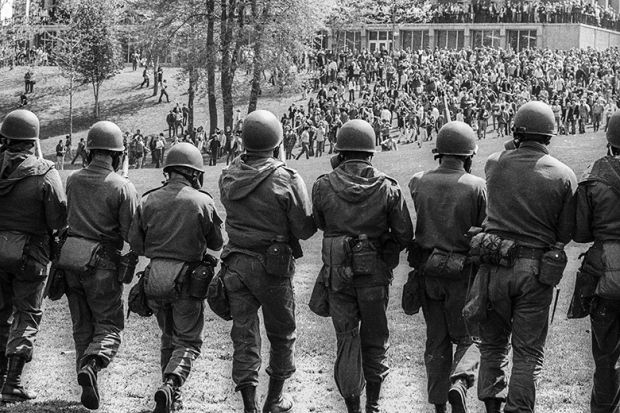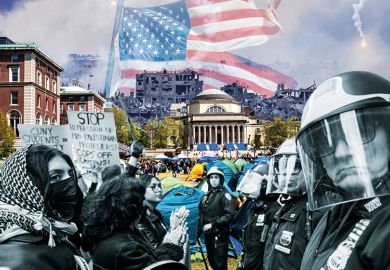The scenes of New York police forcefully arresting and then dragging handcuffed Columbia University students into buses may have fallen mercifully short of the National Guard’s infamous clearance of the Kent State University campus in 1970, but in other ways what we have seen on US campuses in recent weeks is daily more disturbing than what occurred half a century ago.
“It’s student demonstration time all over again” is too often the tone of both academic and journalistic commentators regarding the wave of pro-Palestinian lives protests that are sweeping across the US and elsewhere following Columbia’s initial crackdown on a pro-Palestine protest sparked by its president’s perceived capitulation before a congressional hearing on alleged antisemitism.
The 1960s student protests in favour of free speech and civil rights and against the Vietnam War are evoked routinely. But there are crucial differences between then and now regarding both the protests themselves and universities’ responses to them, which few of the commentaries pick up. These differences reveal a great deal about changes in administration-student (and administration-faculty) relationships, including the “rights” of students. They also cast light on the contemporary absence of clear, thoughtful, education-led responses by administrators.
As a Jewish-American historian who was a student activist in the late 1960s, I recall that the anti-war movement developed over time, intellectually, ideologically and organisationally, as part of wider struggles for student free speech and related rights, beginning with Berkeley’s free speech movement and Tom Hayden’s Port Huron Statement, which inaugurated the highly influential Students for a Democratic Society at Michigan. Today’s student protesters are less organised and more spontaneous: it is only seven months since Hamas’ 7 October massacre, which sparked Israel’s minority government to invade Gaza and kill, thus far, at least 34,000 Palestinians, the majority women and children.
Today’s claims that protests in support of innocent Palestinian lives are “antisemitic” are no more focused or substantiated than allegations of communist influences from the late 1940s or “anti-Americanism” in the 1960s. Nor is the tired old rhetoric emphasising the power of “external influences” on “impressionable” young students any more convincing. But one thing that has changed is the power of “external influences” on administrators and boards.
While such influences have always existed, they are, despite appearances to the contrary, much more concentrated and unambiguous today. The off-campus pro-Israel campaign actually preceded 7 October, beginning with pressure on universities to cancel on-campus events – arts-based as often as political – with Palestinian and Palestinian-American presenters. Elizabeth Magill’s path to forced resignation from the University of Pennsylvania, for instance, began with her refusal to ban a literary festival.
Throughout events since, wealthy alumni have threatened to withhold or withdraw their donations. The organised campaign has not only weaponised so-called antisemitism but also, in the notorious case against Claudine Gay at Harvard, falsely termed “plagiarism” as well.
The forced resignations of Gay and Magill followed the public witch-hunt (I use the words advisedly) that centred on the Republican-dominated House of Representatives Education and Workforce Committee’s December assault on them (alongside another Ivy League woman president, MIT’s Sally Kornbluth). They were quickly followed by a continuing series of demands to the US Department of Justice and Department of Education to investigate allegations of civil rights violations based overwhelmingly on assertions of “antisemitism”.
Let me be clear: there is antisemitism on campuses and in society more generally. I have confronted it myself. But there is also Islamophobia. The evidence suggests the former is exaggerated while the latter is much more often ignored; Title VI claims of Islamophobia have been much smaller in number.
This is not accidental. The complaints about “antisemitism” appear to be coordinated by various well-funded pro-Israel organisations and follow a pattern that began with elite universities before moving on to the major large public universities, as well as some smaller public and private colleges. The complainants file multiple sets of allegations at the same institutions, frequently characterised by wide gaps between their clearly hyperbolic rhetoric and their general absence of concrete evidence. Rudeness and casual comments made in passing are confused with specific violations of campus codes of conduct and public law.
Without paying attention to this context and succession of actions, we cannot understand why a continuing series of university presidents are calling in campus police and then, quickly, local police and state troopers to respond to peaceful student protests. Other universities evidently share Columbia’s view on the importance of “looking tough” while achieving just the opposite of the respectful campus environments they claim to cherish. Columbia’s initial arrests actually began a national student movement.
More than 1,300 young people have been arrested, often illegally and on no more than suspicion of hypothetical threats, nebulous allegations of trespassing or purported violations of undefined noise standards. Unnecessary force and physical violence by police are common. Well-established rights of speech and assembly are ignored.
This organised, multi-level combined public and private attack on the foundations of student and faculty intellectual and ethical life is without precedent. It all but forces presidents to act quickly and publicly to repress pro-Palestinian protests for fear of being hounded out of office. Rather than pushing back against attacks on their students, as they did in the 1960s, administrators have now been drafted into the attack force.
How can we have learned so little?
Harvey J. Graff is professor emeritus of English and history, inaugural Ohio Eminent Scholar in literacy studies and academy professor, Ohio State University. Author of many books on literacy, children and youth, cities and interdisciplinarity, he is writing Reconstructing the “Uni-versity” from the Ashes of the “Multi- and Mega-versity”.
Register to continue
Why register?
- Registration is free and only takes a moment
- Once registered, you can read 3 articles a month
- Sign up for our newsletter
Subscribe
Or subscribe for unlimited access to:
- Unlimited access to news, views, insights & reviews
- Digital editions
- Digital access to THE’s university and college rankings analysis
Already registered or a current subscriber?







